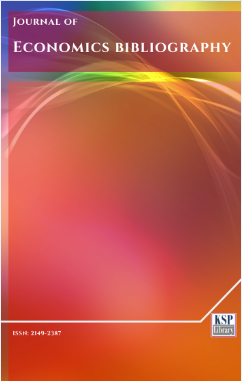The Ranking of Researchers by Publications and Citations: Using RePEc Data
Abstract
Abstract. Researcher-level metrics assess a researcher’s publications and number of citations for each publication. This paper tests empirically 28 two-variable metrics, 26 of which are new in this paper, determined as geometric means from eight one-variable metrics. The 54 highest ranked researchers in RePEc are considered, 13 of whom are Nobel prize winners. One new one-variable metric, the number of citations for the 10th most cited publication, is introduced. Characteristics of the eight one-variable metrics are considered, illustrating why two-variable metrics are needed. The 54 researchers are ranked for all 36 metrics. The lowest sum of ranks for the 13 Nobel prize winners occurs for metric , the number of citations for the highest cited publication. The 13 Nobel prize winners have on average 5.3 higher rank on than on , suggesting a need for being widely cited, not captured by the -index. The metric , the square root of the product of the number of publications and the citation count, proposed as an interesting metric, correlates best with the RePEc scores. Correlations between the 36 metrics are determined. The 28 two-variable metrics are tentatively ranked according to how they capture characteristics apparently not captured by the one-variable metrics.
Keywords. Scientific impact indices, Metrics, RePEc, Publications, Citations, Research output, Indices , , , , , , , , Ranking.
JEL. A12, A14, C00.
Keywords
References
Alonso, S., Cabrerizo, F.J., Herrera-Viedma, E., & Herrera, F. (2010). hg-index: a new index to characterize the scientific output of researchers based on the h- and g-indices. Scientometrics, 82(2), 391-400. doi. 10.1007/s11192-009-0047-5
Blundell, R., & Bond, S. (1998). Initial conditions and moment restrictions in dynamic panel data models. Journal of Econometrics, 87(1), 115-143. doi. 10.1016/S0304-4076(98)00009-8
Bornmann, L., Mutz, R., & Daniel, H.-D. (2010). The h index research output measurement: Two approaches to enhance its accuracy. Journal of Informetrics, 4(3), 407-414. doi. 10.1016/j.joi.2010.03.005
Coase, R.H. (1937). The Nature of the Firm. Economica, 4(16), 386-405. doi. 10.1111/j.1468-0335.1937.tb00002.x
De Visscher, A. (2011). What does the g‐index really measure? Journal of the American Society for Information Science and Technology, 62(11), 2290-2293. doi. 10.1002/asi.21621
Dorogovtsev, S. N., & Mendes, J. F. F. (2015). Ranking scientists. Nature Physics, 11(11), 882-883. doi. 10.1038/nphys3533
Egghe, L. (2006). Theory and practise of the g-index. Scientometrics, 69(1), 131-152. doi. 10.1007/s11192-006-0144-7
Google Scholar. (2011). Google Scholar Citations Open To All. [Retrieved from].
Harsanyi, J.C. (1967). Games with Incomplete Information Played by "Bayesian" Players, I-III. Part I. The Basic Model. Management Science, 14(3), 159-182. doi. 10.1287/mnsc.14.3.159
Hirsch, J.E. (2005). An index to quantify an individual's scientific research output. Proceedings of the National Academy of Sciences of the United States of America, 102(46), 16569-16572. doi. 10.1073/pnas.0507655102
Hume, D. (1740). A Treatise of Human Nature: Being an Attempt to Introduce the Experimental Method of Reasoning into Moral Subjects. Auckland: The Floating Press, 2009.
Medo, M., & Cimini, G. (2016). Model-based evaluation of scientific impact indicators. Physical Review E, 94(032312). doi. 10.1103/PhysRevE.94.032312
Seiler, C., & Wohlrabe, K. (2012). Ranking economists on the basis of many indicators: An alternative approach using RePEc data. Journal of Informetrics, 6(3), 389-402. doi. 10.1016/j.joi.2012.01.007
Wildgaard, L., Schneider, J., & Larsen, B. (2014). A review of the characteristics of 108 author-level bibliometric indicators. An International Journal for all Quantitative Aspects of the Science of Science, Communication in Science and Science Policy, 101(1), 125-158. doi. 10.1007/s11192-014-1423-3
Wu, Q. (2010). The w-Index: A Measure to Assess Scientific Impact by Focusing on Widely Cited Papers. Journal of the American Society for Information Science and Technology, 61(3), 609-614. doi. 10.1002/asi.21276
Zhang, C.T. (2009). The e-Index, Complementing the h-Index for Excess Citations. PloS One, 4(5). doi. 10.1371/journal.pone.0005429
Zimmermann, C. (2012). Academic rankings with RePEc (Vol. 2012-023): Federal Reserve Bank of St. Louis.
DOI: http://dx.doi.org/10.1453/jeb.v3i4.1085
Refbacks
- There are currently no refbacks.
.......................................................................................................................................................................................................................................................................................................................................
Journal of Economics Bibliography - J. Econ. Bib. - JEB - www.kspjournals.org
ISSN: 2149-2387.
Editor: jeb@ksplibrary.org Secretarial: secretarial@ksplibrary.org Istanbul - Turkey.
Copyright © KSP Library

